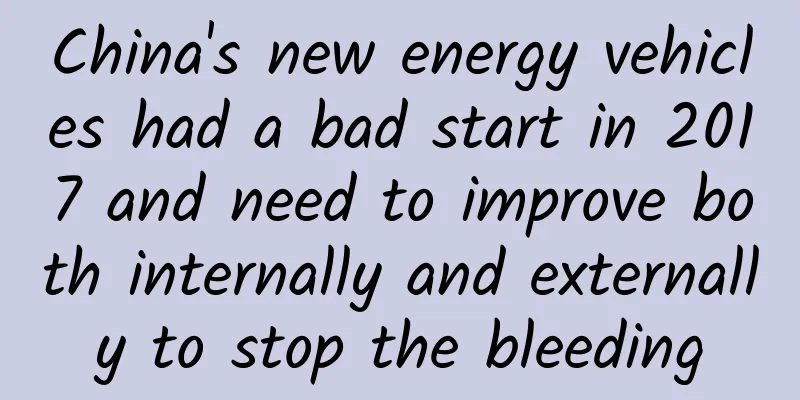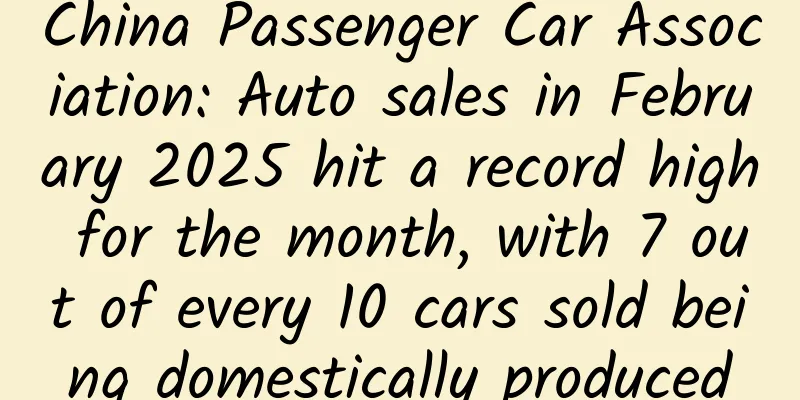China's new energy vehicles had a bad start in 2017 and need to improve both internally and externally to stop the bleeding

|
At the beginning of the new year, China's new energy vehicle sales plummeted. According to the data from the China Passenger Car Association, the sales volume of new energy passenger vehicles in January 2017 was 5,400, a sharp drop of 61% year-on-year. This figure is far less than the average monthly sales volume of new energy vehicles of BYD alone in 2016. Among them, BYD's sales volume of new energy passenger vehicles in January this year was only 605. In the same period last year, BYD's sales volume of the plug-in hybrid model Tang alone reached 4,012 units, and the sales volume of another plug-in hybrid model Qin also reached 517 units. As for why there was a sharp drop in sales in January this year, a BYD insider said in an interview with the First Financial reporter yesterday that the new energy subsidy policy has been delayed and there is a policy window period, which has caused considerable trouble for the pricing of new energy vehicles in January this year. For example, BYD's sales of new energy commercial vehicles in January this year were only a few, but in fact there were several thousand intended orders negotiated before. The two parties had not signed a contract because the subsidy policy had not been issued, and the Spring Festival holiday and other comprehensive factors led to a decline in sales in January. The new policy on subsidies for new energy vehicles in 2017 was not officially released until December 30, 2016. Automakers that needed to make pricing plans in advance were generally on the sidelines when the policy was not clear before, and were unable to make efforts in January this year. Cui Dongshu, secretary-general of the National Passenger Vehicle Market Information Joint Conference, said in an interview with the First Financial reporter that without clear subsidies and catalogs, it would be difficult for automakers to produce for a while. New energy passenger vehicles in January this year showed a low production and sales feature ready to go. This is also a temporary phenomenon during the process of subsidy reduction and announcement review of new energy vehicles at the beginning of the year. With the release of the first batch of new energy promotion catalogs, new energy vehicles will be on the right track in February, and it is expected that the sales of new energy vehicles this year will reach 750,000 units. Sluggish start According to the new policy, starting from January 1 this year, the subsidies for pure electric passenger cars will be reduced from 25,000, 45,000, and 55,000 to 20,000, 36,000, and 44,000 yuan respectively according to different driving ranges, and the subsidies for plug-in hybrid passenger cars will also be reduced from 30,000 to 24,000 yuan. At the same time, according to the new policy, the local government's per-vehicle subsidy shall not exceed 50% of the central government's, and the local government's subsidy of 1:1 with the central government will also become history, with a sharp decline. Combined with the national subsidy and the local subsidy, the government subsidy for purchasing new energy passenger cars in 2017 will be reduced by up to 44,000 yuan. At the same time, on February 9, the Beijing Municipal Commission of Economy and Information Technology issued an official document announcing the adjusted new energy vehicle subsidies and other related policies. According to the latest national requirements, Beijing's new energy passenger car financial subsidy standard will be implemented at 50% of the central government's subsidy standard, and the two-level financial subsidies will not exceed 60% of the vehicle's sales price. If implemented in this way, the maximum subsidy for purchasing pure electric vehicles in Beijing this year will be reduced by about 40% compared to last year. The increase in car purchase costs will inevitably affect consumers' enthusiasm for car purchases. In addition, many local governments have not yet issued detailed rules for new energy vehicle subsidies this year, so companies are also taking a wait-and-see attitude on sales pricing. Reporters learned from several new energy vehicle 4S stores in Shanghai, including Geely, BYD and SAIC, that since local policies are not clear at present, new energy vehicles are mainly "pre-ordered", which also caused the dismal sales of new energy vehicles in January. This is just the beginning. According to national plans, subsidies for new energy vehicles in 2018 will be further reduced by 20% based on this year. By 2020, the new energy vehicle industry will be expected to say goodbye to subsidies completely. In this context, are there still people willing to buy new energy vehicles? According to current data, although the sales of new energy vehicles have been rising in the past two years, in fact, statistics show that among the 379,000 new energy vehicles sold in 2015, only 80,000 were purchased by private individuals, and about 60,000 of them were sold to the six major cities with purchase and traffic restrictions, namely Beijing, Shanghai, Guangzhou, Shenzhen, Tianjin and Hangzhou, accounting for about 70% of private consumption. In the context of subsidy withdrawal and declining policy incentives, how to make new energy vehicles "please" the market has become the most critical issue facing new energy vehicle companies. New cars drive the market Despite the sluggish start, the industry is not pessimistic about the trend of the new energy vehicle market this year, and generally predicts that it will show stable growth. Gao Xiaobing, deputy director of Gaogong Industry Research Institute, said in an interview with the First Financial reporter that the new energy vehicle industry, which has experienced the "subsidy fraud" storm, will gradually return from the original extensive growth to rational growth. New energy vehicles have risen to the level of national strategy, and the general trend of the country to encourage the development of new energy will not change. It is expected that the sales of new energy vehicles this year will be about 750,000 to 800,000 vehicles. Wu Hui, director of new energy at CCID Consulting, also said in an interview with the First Financial reporter that the base of new energy vehicles is small and there is still a lot of room for development in the future. However, the growth of new energy vehicles has gradually stabilized and is no longer as rapid as in the past two years. It is expected that the sales volume this year will be around 700,000 vehicles. According to statistics from the China Association of Automobile Manufacturers, sales of new energy vehicles in 2016 reached 507,000 units, up 53% from the same period last year. This is lower than the original forecast of 700,000 units for 2016, mainly due to the subsidy fraud incident and the delay in the issuance of subsidy policies. After the Ministry of Industry and Information Technology announced last year that it would punish five car companies including Suzhou GMC and Suzhou Kinglong for fraudulent subsidies, it recently held seven car companies including Chongqing Lifan and Zhengzhou Nissan accountable for fraudulent subsidies. Gao Xiaobing said that China's new energy vehicle market has gone through the initial stage of crossing the river by feeling the stones, and it is inevitable that some car companies will exploit policy loopholes. After the adjustment period in 2016, the market has gradually returned to rationality and order, and truly capable companies will begin to rise to the occasion. As for whether the subsidies are too high, this should be divided into two parts. For companies that truly use the positive development of new energy vehicles, the R&D expenses are easily tens of billions of yuan, and the government subsidies are actually insufficient. However, for some models or car companies with less R&D investment, or even just developing on the basis of the original fuel vehicles, the subsidies are obviously too high. The subsidies for new energy vehicles have been exploited by some car companies, and the state's punishment and crackdown on these companies will be conducive to the healthy development of the new energy vehicle market. "At present, domestic enterprises' new energy vehicles are developing rapidly in core technologies such as power batteries and engines, and it is possible to overtake others and transform China from a 'big automobile country' to a 'strong automobile country'. Although the national new energy subsidies are declining year by year, the country is increasing its support for some major scientific and technological projects, which is different from the previous model of providing subsidies to vehicle manufacturers for new energy vehicles." Gao Xiaobing said. At the Electric Vehicle Hundred People Forum held in mid-January this year, Song Qiuling, deputy director of the Economic Construction Department of the Ministry of Finance, said that the stability and continuity of the subsidy policy are crucial to the stable development of the industry. The formulation of the new energy vehicle subsidy policy adheres to three points: first, the general direction of support remains unchanged. Second, the support period remains unchanged. Third, the overall support intensity remains stable. Given that electrification is one of the development aspects of automobiles and the country's general direction of supporting new energy vehicles remains unchanged, many automakers have accelerated the pace of developing new energy vehicles. In terms of plug-in hybrid models, BYD has three series: Tang, Qin and Yuan. The company's Tang and Qin series are about to welcome the addition of upgraded models. The two new cars, Qin 100 and Tang 100, will be officially launched on the 27th of this month. Independent automakers such as BAIC, Changan, Geely, JAC, and Huatai have also accelerated the launch of new energy vehicles. Among them, BAIC New Energy will launch 5 new models in 2017, with a sales target of 200,000 vehicles. In addition, international auto giants have also announced their new energy vehicle plans in China. Among them, Volkswagen will launch 8 new energy models in China in the future, and the Audi A6 Le-tron will be launched in early 2017. This is Audi's first domestically produced plug-in hybrid model. Zhang Xiaofei, chairman of Gaogong Industry Research Institute, pointed out that there are currently 176 new energy vehicle manufacturers, and the new players or those preparing to enter the market are mainly concentrated in the passenger car market. It is expected that in 2017, more than 60 new models of new energy passenger cars will be launched, and in the second half of 2017, the new energy passenger car market will usher in a breakout point. Zhang Xiaofei also said that with the decline of subsidies and the entry of foreign brands, China's new energy vehicle industry will undergo major changes. On the one hand, the liberalization of new energy vehicle production qualifications and the emergence of Internet car companies to subvert the future will promote the development of the electric vehicle market to a certain extent. On the other hand, with the decline of subsidies, foreign brands will gradually accelerate their competition in China's new energy market, and the competitive landscape in the electric passenger vehicle field is expected to be reshaped. Reduce costs New cars will promote the growth of the new energy vehicle market. However, new energy vehicle companies still cannot avoid the impact of the adjustment of new energy subsidy policies. The top priority is to digest the cost increase caused by the subsidy reduction as soon as possible. Not only has the subsidy been reduced, the new policy has also raised the threshold for the recommended vehicle model catalog and adjusted it dynamically. Specifically, it has raised the entry threshold for financial subsidies in terms of vehicle energy consumption, driving range, battery performance, safety requirements, and other aspects. This has forced new energy vehicle manufacturers to further improve their internal strength, enhance technology, and reduce costs. "In the long run, the competitors of electric vehicles are not local electric vehicle companies or multinational companies, but traditional fuel vehicles." Zeng Yuqun, founder of Contemporary Amperex Technology Co., Ltd., gave a speech at the Electric Vehicle Hundred People Conference in January this year. He believed that if there is no way to compete with fuel vehicles, electric vehicles will not be able to be fully marketed after the subsidies are withdrawn. Wang Xiaoqiu, general manager of SAIC Passenger Vehicle, also expressed this view in an interview with the First Financial reporter. Zeng Yuqun previously revealed that when he communicated with European, American and Japanese auto giants, the latter proposed a goal that by around 2020, in the absence of any subsidies, the price of electric vehicles and fuel vehicles would be completely equal. Under this premise, electric vehicles can replace 50% of fuel vehicles. Like traditional cars, the main cost of new energy vehicles comes from three core components: batteries, motors, and electronic control systems, of which the battery system cost accounts for 30% to 50% of the total. It is understood that the energy and industrial planning departments of major economies such as the United States, Japan, and the European Union have long formulated relevant planning routes, especially involving the reduction of battery costs. For example, the route plan released by the Ministry of Economy, Trade and Industry of Japan in 2013 stated that the battery cost will be reduced to 20,000 yen/kW·h (about 170 US dollars/Wh) around 2020. Others such as the International Energy Agency (IEA) and the US Department of Energy also predict that around 2020, the battery cost will be below 200 US dollars/kW·h. According to the "2025 Manufacturing Plan" released by the Ministry of Industry and Information Technology last year, by then, the cost of power batteries will reach 0.8 yuan/kW·h (about 116 US dollars/kW·h). According to Ouyang Minggao, executive vice president of the China Electric Vehicle Hundred People's Association, if the battery cost is reduced to 30,000 yuan for a car battery system with a range of 350km, electric vehicles will have a cost advantage that competes with fuel vehicles. However, according to people from power battery and vehicle companies, it is basically impossible for the cost of power batteries to drop significantly in the short term given the current high material costs. Therefore, the "burden" of reducing costs will fall on the shoulders of reducing the costs of core components such as motors and electronic controls in the short term. For car companies, there are three main ways to achieve cost reduction: one is to increase scale; the second is to master core technologies and control the supply chain in their own hands; in addition, realizing the platformization of new energy vehicles is also a major way. However, at present, most domestic new energy vehicle manufacturers have not developed new platforms for new energy vehicles, but have modified existing models, which is different from foreign car companies. At the same time, the core components of new energy vehicles are still mostly in the hands of foreign capital, and there are very few domestic car companies that have mastered the core technologies of the three electrics. At present, compared with vehicle manufacturers, power battery companies in the upstream of the new energy vehicle industry are under greater pressure - it is difficult for the main car manufacturers to pass on the rising costs to consumers, and they can only digest them internally and put forward higher requirements on the costs of upstream battery suppliers. Wu Hui believes that the pressure will be transmitted to upstream power battery manufacturers and will affect the decline in battery prices. It is expected that the profits of power battery manufacturers will drop from 20% to about 10%. Under the baton of the new round of subsidy policies, car companies have given power battery companies the requirements of reducing costs by as much as 20% to 50%. As a result, the entire power battery industry will face extremely severe challenges in 2017. The pressure of reducing costs and accounts receivable, the pressure of capacity expansion, the pressure of improving product performance, and the pressure of fluctuations in raw material prices are like many mountains pressing on power battery companies. As a winner of Toutiao's Qingyun Plan and Baijiahao's Bai+ Plan, the 2019 Baidu Digital Author of the Year, the Baijiahao's Most Popular Author in the Technology Field, the 2019 Sogou Technology and Culture Author, and the 2021 Baijiahao Quarterly Influential Creator, he has won many awards, including the 2013 Sohu Best Industry Media Person, the 2015 China New Media Entrepreneurship Competition Beijing Third Place, the 2015 Guangmang Experience Award, the 2015 China New Media Entrepreneurship Competition Finals Third Place, and the 2018 Baidu Dynamic Annual Powerful Celebrity. |
<<: How did Xiaomi's ecological chain go astray and then get out of control?
Recommend
Beijing Health Code was attacked! What are the tactics of cyber attacks?
|||| Written by reporter Zhao Tianyu Edited by Li...
How to acquire the first batch of seed users when you have no money, no people, and no fame?
In the early stages of a business , when you are ...
Wisdom teeth, should they be removed or not? It has nothing to do with whether your face is big or small
"Toothache is not a disease, but it is reall...
3 tips to increase followers on Zhihu for free!
Many people understand that I often change my ide...
How to build a brand? Brand building methodology!
Without a brand, your product will be trapped in ...
Apple releases iOS 9.0.1, fixes multiple bugs
Today, Apple released iOS 9.0.1, a minor update t...
Sharing practical experience on WeChat group fission!
Starting last year, the term "private domain...
Domestic cars can also be so cool. Roewe i6 opens a new chapter of intelligent interconnection
At the 2016 Guangzhou Auto Show, SAIC Roewe relea...
Here will be another major scientific facility! How will the world's first "zero magnetic" space expand the boundaries of humankind?
Large scientific facilities are called "the ...
How to create Alipay mini program and join Taobao mini program?
Q: How to create Alipay mini program and join Tao...
Common problems after Swift open source
[[136884]] Apple said it would make Swift an open...
Can the ketogenic diet starve cancer cells to death and help anti-cancer drugs eliminate tumors?
gossip "The ketogenic diet can starve cancer...
User reading is fragmented, how to improve conversion rate?
According to the research report "Special An...
Douban, the mobile Internet can no longer wait for your confusion
A few days ago, when I was chatting with some ent...
Tencent advertising skills and common problems!
This article shares with you some difficult probl...









